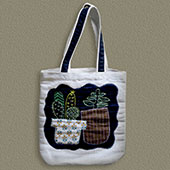Design Resource
Jute Bag Making, Bengaluru - Karnataka
Craft of the Golden Fiber
by
Prof. Bibhudutta Baral and Hariharasudan T.
Jute, known as The Golden Fiber is a natural fiber with a golden and silky shine. As a plant jute (Corchorus Capsularis and Corchorus Olitorius) was believed to have been cultivated around 800 B.C. It is the cheapest vegetable fiber procured from the bark or skin of the plant's stem. It has high tensile strength, and low extensibility, and ensures better breathability of fabrics. Jute fiber is 100% bio-degradable and recyclable and thus environmentally friendly. Its luster determines quality; the more it shines, the better the quality. Jute has good insulating and antistatic properties, as well as low thermal conductivity and moderate moisture regain. It includes acoustic insulating properties and manufactures with no skin irritations.
Jute has been used in India on family farms for centuries. It was twisted into cordage and made into twine and ropes to be used on the farm. The jute, left after the fiber is extracted, was used as firewood. There are even several historical recordings of jute in earlier days. Mughal king Akbar encouraged the villagers of India to wear clothes made of jute during his period 1542-1605. In Bengal, ropes and twines were made of white jute for household and other uses. Parts of the Jute plant have been used since ancient times in Africa and Asia. The stem is used in weaving and leaves for food.
During the 19th and early 20th centuries, jute was indispensable. It was used in making sacks, ropes, boot linings, aprons, carpets, tents, roofing felts, satchels, linoleum backing, tarpaulins, sandbags, electric cable, and even parachutes. Jute appealed to the people because of its strength, low cost, durability and versatility. Jute started to be exported in the 1880s when a system for spinning and weaving was developed in Dundee (Scotland), where there is now a jute museum. Margaret Donnelly, a jute mill owner in Dundee, set up the first jute mill in Bengal. In the years the 1950s and 1960s, when nylon and polythene were rarely used, one of the primary sources of foreign exchange earnings was the jute products. It was also used in the military during the British regime.
Jute is an annual crop taking approximately about 120 days to grow. It thrives in a tropical climate with humidity of 60% to 90%. Jute is a rain-fed crop with little need for fertilizer or pesticides. Yields are about 2 tons of dry jute fiber per hectare. Jute is one of the most affordable natural fibers and is considered second only to cotton in the amount produced and variety of uses of vegetable fibers. Jute is planted close together so that the plants grow tall and straight.
Jute has a low carbon footprint, it is biodegradable, feeds the soil and all parts of the plant can be used. Jute plants help to clean the air; during growth they assimilate three times more CO2 than the average tree, converting the CO2 into oxygen. As well as having little need for fertilizers and pesticides, jute plants enrich the soil. As these plants grow fast, they are often used in crop rotation. The leaves and roots left after harvest enrich the soil with micronutrients, maintaining soil fertility. When used as a geotextile, it puts nutrients back in the soil when it decomposes.






